UTS 15315 Project Management: Self-Reflection Essay on Learning Styles
VerifiedAdded on 2023/04/08
|16
|4091
|343
Report
AI Summary
This report is a self-reflective essay analyzing a student's learning style and teamwork preferences within the context of project management principles. The student completed the Honey-Mumford Learning Styles Questionnaire and the Belbin Teamwork Self-Perception Inventory to identify their preferred learning style and team role. The essay provides an overview of the test results, identifying the student as a "Theorist" according to Honey-Mumford and a "Shaper" according to Belbin. The student then describes a project-related event where their learning style and team role were evident, analyzing their behaviors and experiences in relation to the test results. The report emphasizes the importance of understanding personal learning styles and their impact on teamwork within a project environment. The student concludes by summarizing their findings and reflecting on the practical implications of their preferred styles and roles in project management.
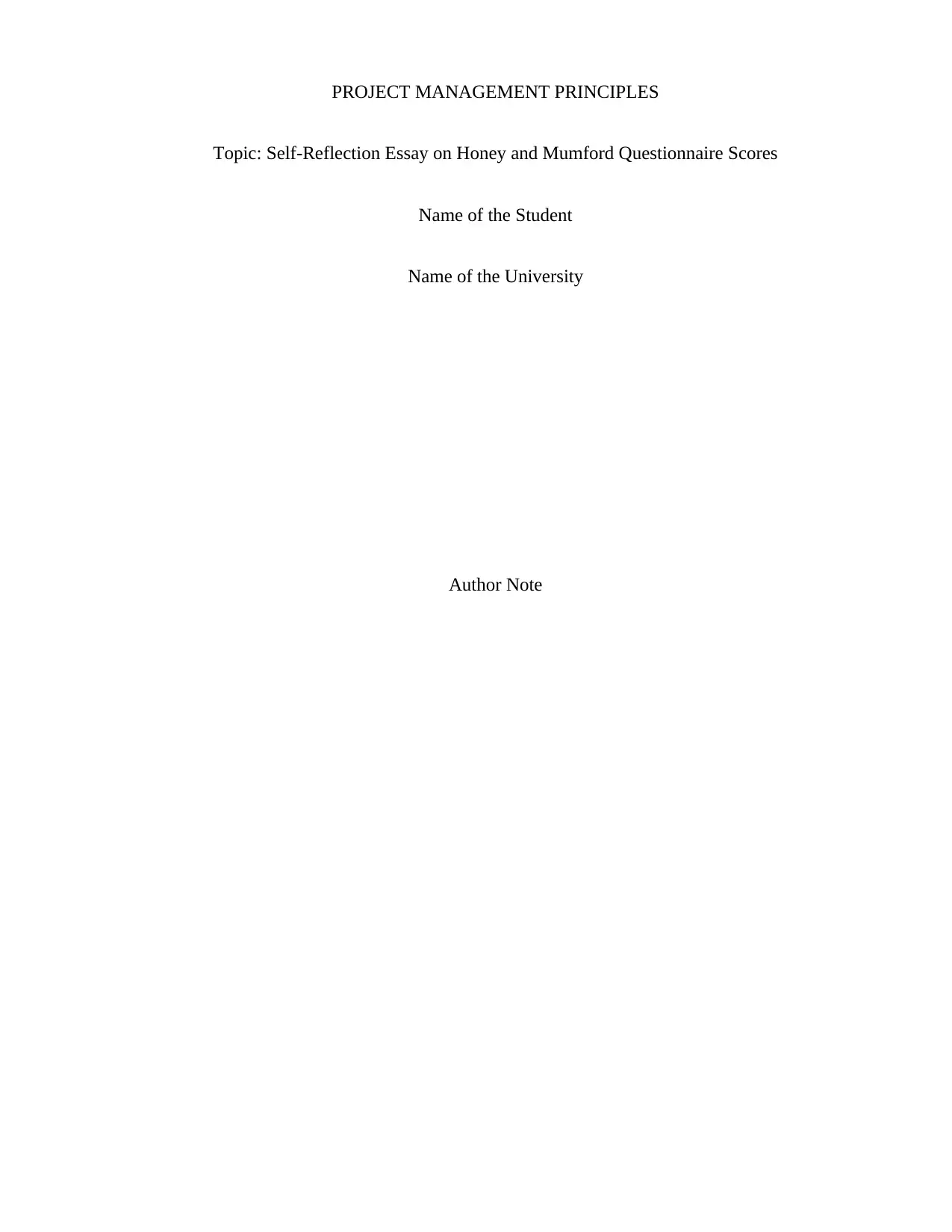
PROJECT MANAGEMENT PRINCIPLES
Topic: Self-Reflection Essay on Honey and Mumford Questionnaire Scores
Name of the Student
Name of the University
Author Note
Topic: Self-Reflection Essay on Honey and Mumford Questionnaire Scores
Name of the Student
Name of the University
Author Note
Paraphrase This Document
Need a fresh take? Get an instant paraphrase of this document with our AI Paraphraser

Table of Contents
1. Test results overview and commentary....................................................................................................3
1.1 Belbin test results................................................................................................................................3
1.2 Honey-Mumford test results...............................................................................................................4
2. Preferred style/profile in practice.............................................................................................................6
2.1 Event/Project description....................................................................................................................6
2.2 Situation where Style/Profile were evident........................................................................................6
2.3 Analysis of the preferred Style/Profile in action................................................................................6
3. Summary...................................................................................................................................................6
Bibliography.................................................................................................................................................8
Appendix.......................................................................................................................................................9
1. Test results overview and commentary....................................................................................................3
1.1 Belbin test results................................................................................................................................3
1.2 Honey-Mumford test results...............................................................................................................4
2. Preferred style/profile in practice.............................................................................................................6
2.1 Event/Project description....................................................................................................................6
2.2 Situation where Style/Profile were evident........................................................................................6
2.3 Analysis of the preferred Style/Profile in action................................................................................6
3. Summary...................................................................................................................................................6
Bibliography.................................................................................................................................................8
Appendix.......................................................................................................................................................9

1. Test results overview and commentary
1.1 Belbin test results
The Belbin test result is carried out to make sure that the analysis of a team of group in a
particular project is in preparation for the discussion with the team so that both the purpose of building a
team and the desired outcome is clear to the people involved. This entire feedback session is designed for
reduction of conflict and improving of the moral along with the following redundancies which are most
likely to be happening at different approaches. I took the test and it was completed in about 15 minutes’
time. This is set according to the Belbin test results. By taking this report I understand the team role for
every individual from their highest to lowest ranking for it needed to see through the roles of every team
member in a prominent way which might be expected from the team composition but is missing from it.
Following would be the results that I took from the Belbin test as per it was conducted:
Section a b c d e f g h Total
1 1 2 1 0 1 1 1 3 10
2 2 0 3 0 4 0 0 1 10
3 2 2 1 1 1 1 1 1 10
4 3 0 0 3 1 1 1 1 10
5 1 1 2 1 1 1 2 1 10
6 1 2 1 1 1 1 1 2 10
7 4 0 0 0 3 0 3 0 10
Grand Total 70
Table 1: Self-Perception Inventory: Points Table
1.1 Belbin test results
The Belbin test result is carried out to make sure that the analysis of a team of group in a
particular project is in preparation for the discussion with the team so that both the purpose of building a
team and the desired outcome is clear to the people involved. This entire feedback session is designed for
reduction of conflict and improving of the moral along with the following redundancies which are most
likely to be happening at different approaches. I took the test and it was completed in about 15 minutes’
time. This is set according to the Belbin test results. By taking this report I understand the team role for
every individual from their highest to lowest ranking for it needed to see through the roles of every team
member in a prominent way which might be expected from the team composition but is missing from it.
Following would be the results that I took from the Belbin test as per it was conducted:
Section a b c d e f g h Total
1 1 2 1 0 1 1 1 3 10
2 2 0 3 0 4 0 0 1 10
3 2 2 1 1 1 1 1 1 10
4 3 0 0 3 1 1 1 1 10
5 1 1 2 1 1 1 2 1 10
6 1 2 1 1 1 1 1 2 10
7 4 0 0 0 3 0 3 0 10
Grand Total 70
Table 1: Self-Perception Inventory: Points Table
⊘ This is a preview!⊘
Do you want full access?
Subscribe today to unlock all pages.

Trusted by 1+ million students worldwide
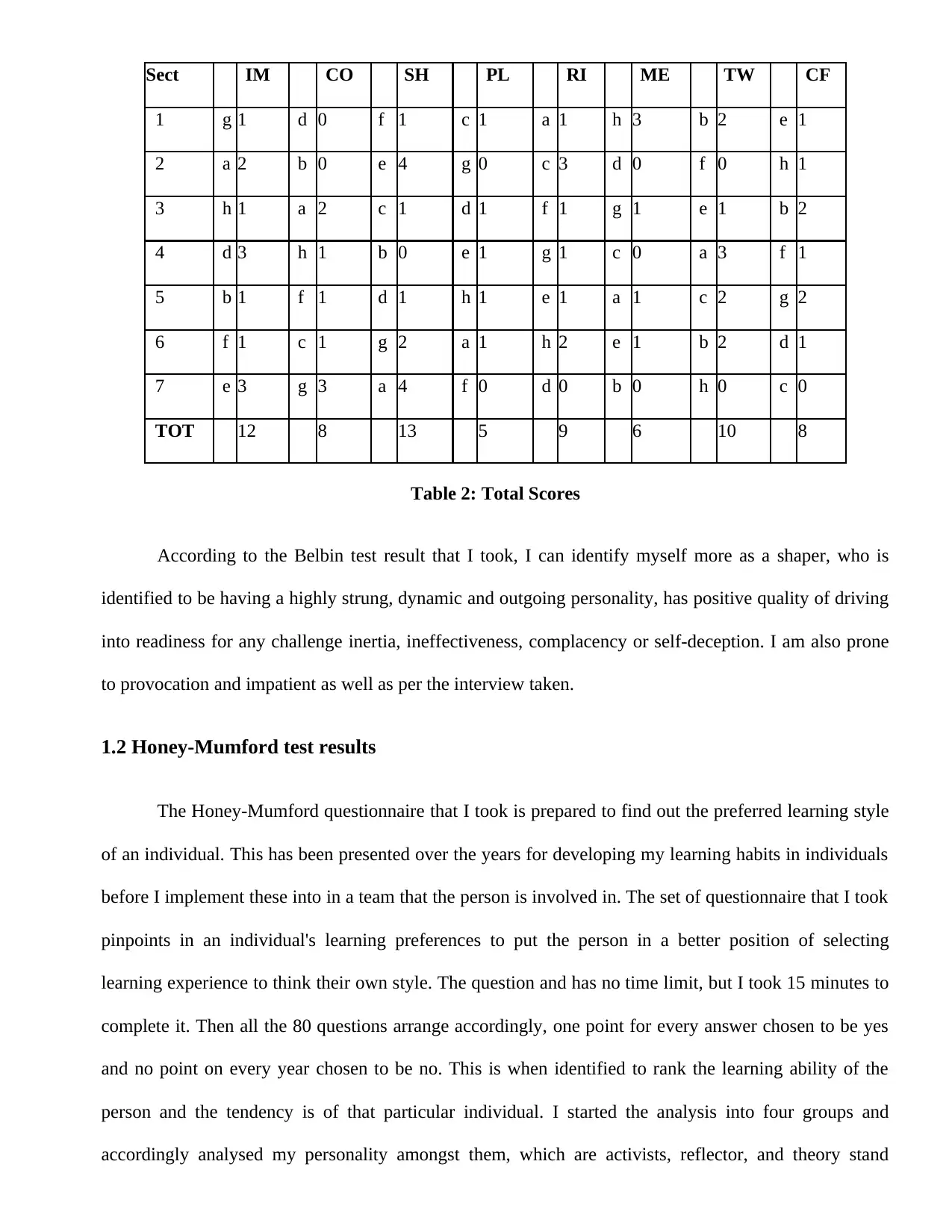
Sect IM CO SH PL RI ME TW CF
1 g 1 d 0 f 1 c 1 a 1 h 3 b 2 e 1
2 a 2 b 0 e 4 g 0 c 3 d 0 f 0 h 1
3 h 1 a 2 c 1 d 1 f 1 g 1 e 1 b 2
4 d 3 h 1 b 0 e 1 g 1 c 0 a 3 f 1
5 b 1 f 1 d 1 h 1 e 1 a 1 c 2 g 2
6 f 1 c 1 g 2 a 1 h 2 e 1 b 2 d 1
7 e 3 g 3 a 4 f 0 d 0 b 0 h 0 c 0
TOT 12 8 13 5 9 6 10 8
Table 2: Total Scores
According to the Belbin test result that I took, I can identify myself more as a shaper, who is
identified to be having a highly strung, dynamic and outgoing personality, has positive quality of driving
into readiness for any challenge inertia, ineffectiveness, complacency or self-deception. I am also prone
to provocation and impatient as well as per the interview taken.
1.2 Honey-Mumford test results
The Honey-Mumford questionnaire that I took is prepared to find out the preferred learning style
of an individual. This has been presented over the years for developing my learning habits in individuals
before I implement these into in a team that the person is involved in. The set of questionnaire that I took
pinpoints in an individual's learning preferences to put the person in a better position of selecting
learning experience to think their own style. The question and has no time limit, but I took 15 minutes to
complete it. Then all the 80 questions arrange accordingly, one point for every answer chosen to be yes
and no point on every year chosen to be no. This is when identified to rank the learning ability of the
person and the tendency is of that particular individual. I started the analysis into four groups and
accordingly analysed my personality amongst them, which are activists, reflector, and theory stand
1 g 1 d 0 f 1 c 1 a 1 h 3 b 2 e 1
2 a 2 b 0 e 4 g 0 c 3 d 0 f 0 h 1
3 h 1 a 2 c 1 d 1 f 1 g 1 e 1 b 2
4 d 3 h 1 b 0 e 1 g 1 c 0 a 3 f 1
5 b 1 f 1 d 1 h 1 e 1 a 1 c 2 g 2
6 f 1 c 1 g 2 a 1 h 2 e 1 b 2 d 1
7 e 3 g 3 a 4 f 0 d 0 b 0 h 0 c 0
TOT 12 8 13 5 9 6 10 8
Table 2: Total Scores
According to the Belbin test result that I took, I can identify myself more as a shaper, who is
identified to be having a highly strung, dynamic and outgoing personality, has positive quality of driving
into readiness for any challenge inertia, ineffectiveness, complacency or self-deception. I am also prone
to provocation and impatient as well as per the interview taken.
1.2 Honey-Mumford test results
The Honey-Mumford questionnaire that I took is prepared to find out the preferred learning style
of an individual. This has been presented over the years for developing my learning habits in individuals
before I implement these into in a team that the person is involved in. The set of questionnaire that I took
pinpoints in an individual's learning preferences to put the person in a better position of selecting
learning experience to think their own style. The question and has no time limit, but I took 15 minutes to
complete it. Then all the 80 questions arrange accordingly, one point for every answer chosen to be yes
and no point on every year chosen to be no. This is when identified to rank the learning ability of the
person and the tendency is of that particular individual. I started the analysis into four groups and
accordingly analysed my personality amongst them, which are activists, reflector, and theory stand
Paraphrase This Document
Need a fresh take? Get an instant paraphrase of this document with our AI Paraphraser
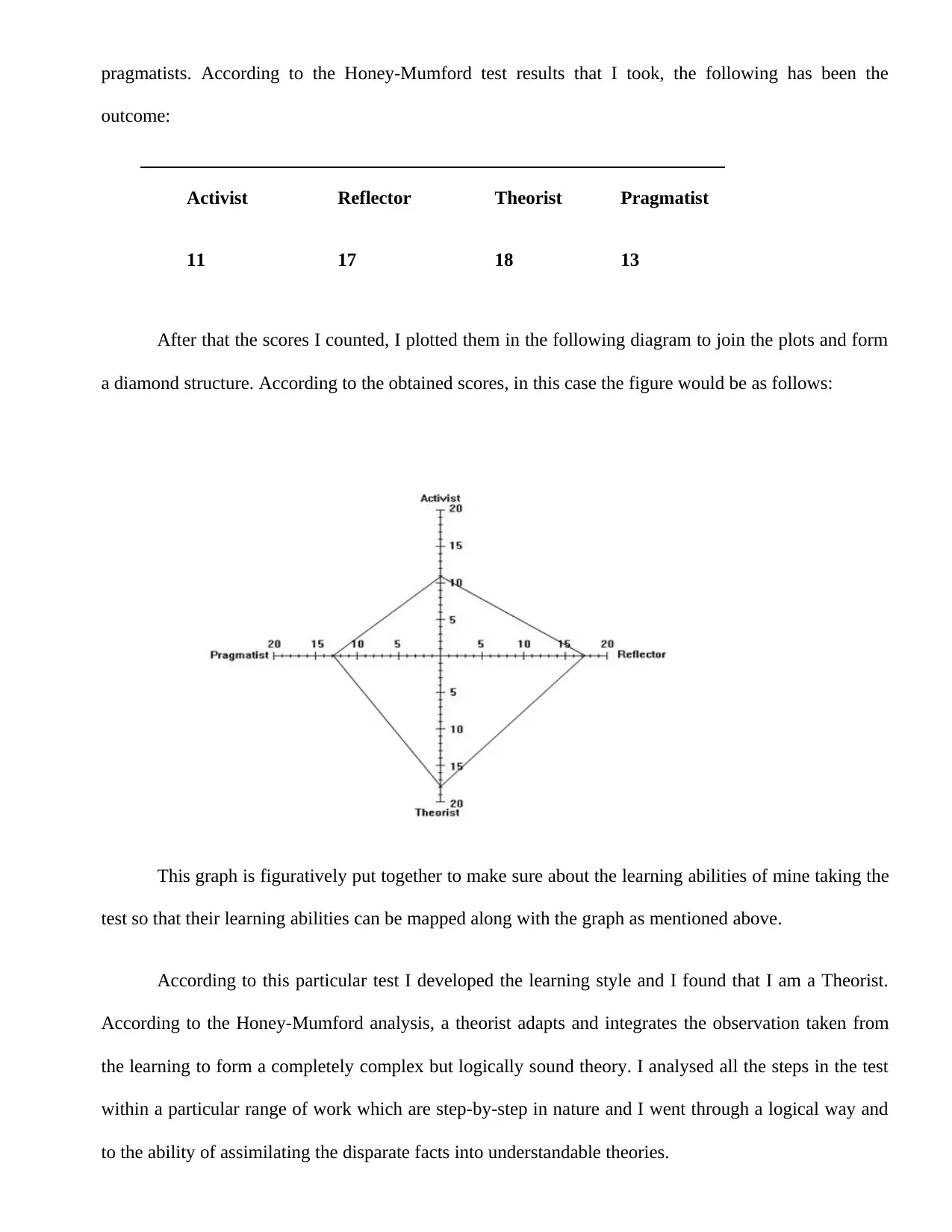
pragmatists. According to the Honey-Mumford test results that I took, the following has been the
outcome:
Activist
11
Reflector
17
Theorist
18
Pragmatist
13
After that the scores I counted, I plotted them in the following diagram to join the plots and form
a diamond structure. According to the obtained scores, in this case the figure would be as follows:
This graph is figuratively put together to make sure about the learning abilities of mine taking the
test so that their learning abilities can be mapped along with the graph as mentioned above.
According to this particular test I developed the learning style and I found that I am a Theorist.
According to the Honey-Mumford analysis, a theorist adapts and integrates the observation taken from
the learning to form a completely complex but logically sound theory. I analysed all the steps in the test
within a particular range of work which are step-by-step in nature and I went through a logical way and
to the ability of assimilating the disparate facts into understandable theories.
outcome:
Activist
11
Reflector
17
Theorist
18
Pragmatist
13
After that the scores I counted, I plotted them in the following diagram to join the plots and form
a diamond structure. According to the obtained scores, in this case the figure would be as follows:
This graph is figuratively put together to make sure about the learning abilities of mine taking the
test so that their learning abilities can be mapped along with the graph as mentioned above.
According to this particular test I developed the learning style and I found that I am a Theorist.
According to the Honey-Mumford analysis, a theorist adapts and integrates the observation taken from
the learning to form a completely complex but logically sound theory. I analysed all the steps in the test
within a particular range of work which are step-by-step in nature and I went through a logical way and
to the ability of assimilating the disparate facts into understandable theories.

2. Preferred style/profile in practice
2.1 Event/Project description
Therefore, my entire project description where both the Honey-Mumford test and Belbin test
results are utilised, reflects how personal learning and teamwork affects my project. This particular
project has been taken upon by me to make sure that all the objectives of having personal learning is
reflected up on the project outcomes when they are taken up. My thinking is based upon an individual to
make sure how that person understands the ability of teamwork and having a personal an individual mind
set towards a project.
2.2 Situation where Style/Profile were evident
My style and profile was evident in any kind of information technology project, construction
project or anywhere, where there is a need of evident teamwork without I think that the entire project
would not succeed.
2.3 Analysis of the preferred Style/Profile in action
I prefer that effective decisions need to be taken even if there are minimum errors found in this
case. This should not depend upon any preferred style or profile to be selected for the analysis other than
having a simple and honest approach towards the entire analysis process. It is necessary to have an
honest approach towards the analysis to make sure that the best possible outcomes are obtained.
3. Summary
After both the test results that I have performed, I could see that my approach towards a specific
project was enriched with a theorist approach in project management. Both the Honey-Mumford and
Belbin test results present a theorist approach towards the way a person views the management of a
project and the people involved with it involving not just the way people work but also their motivation
levels. I have had the opportunity to view this approach through both these tests taken.
2.1 Event/Project description
Therefore, my entire project description where both the Honey-Mumford test and Belbin test
results are utilised, reflects how personal learning and teamwork affects my project. This particular
project has been taken upon by me to make sure that all the objectives of having personal learning is
reflected up on the project outcomes when they are taken up. My thinking is based upon an individual to
make sure how that person understands the ability of teamwork and having a personal an individual mind
set towards a project.
2.2 Situation where Style/Profile were evident
My style and profile was evident in any kind of information technology project, construction
project or anywhere, where there is a need of evident teamwork without I think that the entire project
would not succeed.
2.3 Analysis of the preferred Style/Profile in action
I prefer that effective decisions need to be taken even if there are minimum errors found in this
case. This should not depend upon any preferred style or profile to be selected for the analysis other than
having a simple and honest approach towards the entire analysis process. It is necessary to have an
honest approach towards the analysis to make sure that the best possible outcomes are obtained.
3. Summary
After both the test results that I have performed, I could see that my approach towards a specific
project was enriched with a theorist approach in project management. Both the Honey-Mumford and
Belbin test results present a theorist approach towards the way a person views the management of a
project and the people involved with it involving not just the way people work but also their motivation
levels. I have had the opportunity to view this approach through both these tests taken.
⊘ This is a preview!⊘
Do you want full access?
Subscribe today to unlock all pages.

Trusted by 1+ million students worldwide

Bibliography
Bertoncello, V., Possamai, O., Bortolozzi, F. and Vosgerau, D.S., 2017, April. A Model for the
Development of Learning Objects Using Educational Design. In Proceedings of the 2017 International
Conference on Information System and Data Mining (pp. 111-118). ACM.
Estivalete, V.D.F.B. and Pedrozo, E.A., 2018. From Individual Learning to Interorganizational Learning:
Proposition of an Analysis Framework. Desenvolvimento em Questão, 16(43).
Fidalgo-Blanco, Á., Sein-Echaluce, M.L. and García-Peñalvo, F.J., 2019. Enhancing the main
characteristics of active methodologies: A case with Micro Flip Teaching and Teamwork.
Kumar, R. and Pande, N., 2018. Assessing learning style preference of working professional cohorts in
India: an empirical study using Honey-Mumford's learning style questionnaire. International Journal of
Indian Culture and Business Management, 16(3), pp.245-263.
Meslec, N. and Curşeu, P.L., 2015. Are balanced groups better? Belbin roles in collaborative learning
groups. Learning and Individual Differences, 39, pp.81-88.
Philpott, E. and Owen, D., 2016. Project Management: Practice-Based Learning in a UK University.
In Integrating Curricular and Co-Curricular Endeavors to Enhance Student Outcomes (pp. 143-164).
Emerald Group Publishing Limited.
Sherstyuk, O., Olekh, Т. and Kolesnikova, K., 2016. The research on role differentiation as a method of
forming the project team. Восточно-Европейский журнал передовых технологий, (2 (3)), pp.63-68.
Smith, B. and Dodds, B., 2017. Developing managers through project-based learning. Routledge.
Bertoncello, V., Possamai, O., Bortolozzi, F. and Vosgerau, D.S., 2017, April. A Model for the
Development of Learning Objects Using Educational Design. In Proceedings of the 2017 International
Conference on Information System and Data Mining (pp. 111-118). ACM.
Estivalete, V.D.F.B. and Pedrozo, E.A., 2018. From Individual Learning to Interorganizational Learning:
Proposition of an Analysis Framework. Desenvolvimento em Questão, 16(43).
Fidalgo-Blanco, Á., Sein-Echaluce, M.L. and García-Peñalvo, F.J., 2019. Enhancing the main
characteristics of active methodologies: A case with Micro Flip Teaching and Teamwork.
Kumar, R. and Pande, N., 2018. Assessing learning style preference of working professional cohorts in
India: an empirical study using Honey-Mumford's learning style questionnaire. International Journal of
Indian Culture and Business Management, 16(3), pp.245-263.
Meslec, N. and Curşeu, P.L., 2015. Are balanced groups better? Belbin roles in collaborative learning
groups. Learning and Individual Differences, 39, pp.81-88.
Philpott, E. and Owen, D., 2016. Project Management: Practice-Based Learning in a UK University.
In Integrating Curricular and Co-Curricular Endeavors to Enhance Student Outcomes (pp. 143-164).
Emerald Group Publishing Limited.
Sherstyuk, O., Olekh, Т. and Kolesnikova, K., 2016. The research on role differentiation as a method of
forming the project team. Восточно-Европейский журнал передовых технологий, (2 (3)), pp.63-68.
Smith, B. and Dodds, B., 2017. Developing managers through project-based learning. Routledge.
Paraphrase This Document
Need a fresh take? Get an instant paraphrase of this document with our AI Paraphraser
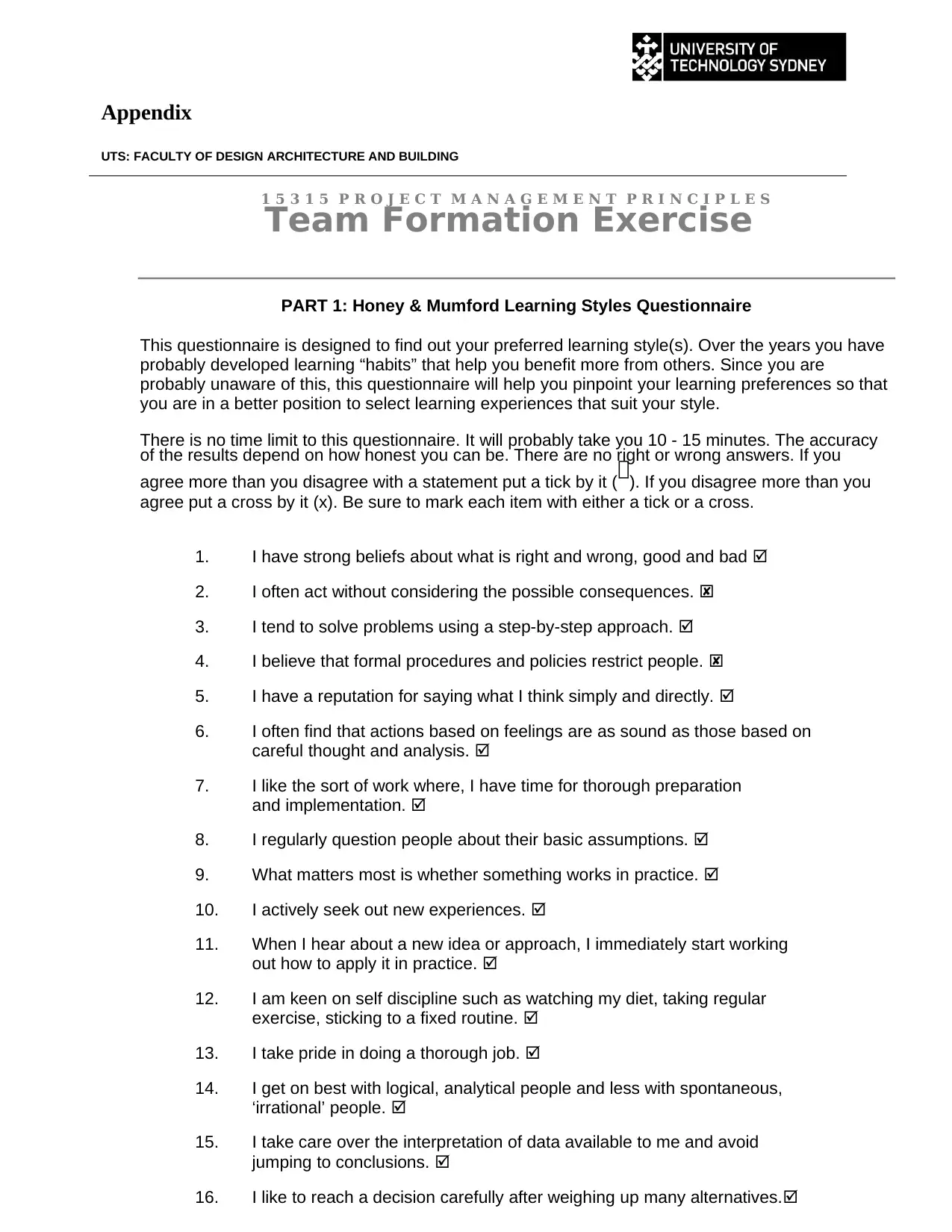
Appendix
UTS: FACULTY OF DESIGN ARCHITECTURE AND BUILDING
1 5 3 1 5 P R O J E C T M A N A G E M E N T P R I N C I P L E S
Team Formation Exercise
PART 1: Honey & Mumford Learning Styles Questionnaire
This questionnaire is designed to find out your preferred learning style(s). Over the years you have
probably developed learning “habits” that help you benefit more from others. Since you are
probably unaware of this, this questionnaire will help you pinpoint your learning preferences so that
you are in a better position to select learning experiences that suit your style.
There is no time limit to this questionnaire. It will probably take you 10 - 15 minutes. The accuracy
of the results depend on how honest you can be. There are no right or wrong answers. If you
agree more than you disagree with a statement put a tick by it (). If you disagree more than you
agree put a cross by it (x). Be sure to mark each item with either a tick or a cross.
1. I have strong beliefs about what is right and wrong, good and bad
2. I often act without considering the possible consequences.
3. I tend to solve problems using a step-by-step approach.
4. I believe that formal procedures and policies restrict people.
5. I have a reputation for saying what I think simply and directly.
6. I often find that actions based on feelings are as sound as those based on
careful thought and analysis.
7. I like the sort of work where, I have time for thorough preparation
and implementation.
8. I regularly question people about their basic assumptions.
9. What matters most is whether something works in practice.
10. I actively seek out new experiences.
11. When I hear about a new idea or approach, I immediately start working
out how to apply it in practice.
12. I am keen on self discipline such as watching my diet, taking regular
exercise, sticking to a fixed routine.
13. I take pride in doing a thorough job.
14. I get on best with logical, analytical people and less with spontaneous,
‘irrational’ people.
15. I take care over the interpretation of data available to me and avoid
jumping to conclusions.
16. I like to reach a decision carefully after weighing up many alternatives.
UTS: FACULTY OF DESIGN ARCHITECTURE AND BUILDING
1 5 3 1 5 P R O J E C T M A N A G E M E N T P R I N C I P L E S
Team Formation Exercise
PART 1: Honey & Mumford Learning Styles Questionnaire
This questionnaire is designed to find out your preferred learning style(s). Over the years you have
probably developed learning “habits” that help you benefit more from others. Since you are
probably unaware of this, this questionnaire will help you pinpoint your learning preferences so that
you are in a better position to select learning experiences that suit your style.
There is no time limit to this questionnaire. It will probably take you 10 - 15 minutes. The accuracy
of the results depend on how honest you can be. There are no right or wrong answers. If you
agree more than you disagree with a statement put a tick by it (). If you disagree more than you
agree put a cross by it (x). Be sure to mark each item with either a tick or a cross.
1. I have strong beliefs about what is right and wrong, good and bad
2. I often act without considering the possible consequences.
3. I tend to solve problems using a step-by-step approach.
4. I believe that formal procedures and policies restrict people.
5. I have a reputation for saying what I think simply and directly.
6. I often find that actions based on feelings are as sound as those based on
careful thought and analysis.
7. I like the sort of work where, I have time for thorough preparation
and implementation.
8. I regularly question people about their basic assumptions.
9. What matters most is whether something works in practice.
10. I actively seek out new experiences.
11. When I hear about a new idea or approach, I immediately start working
out how to apply it in practice.
12. I am keen on self discipline such as watching my diet, taking regular
exercise, sticking to a fixed routine.
13. I take pride in doing a thorough job.
14. I get on best with logical, analytical people and less with spontaneous,
‘irrational’ people.
15. I take care over the interpretation of data available to me and avoid
jumping to conclusions.
16. I like to reach a decision carefully after weighing up many alternatives.

⊘ This is a preview!⊘
Do you want full access?
Subscribe today to unlock all pages.

Trusted by 1+ million students worldwide
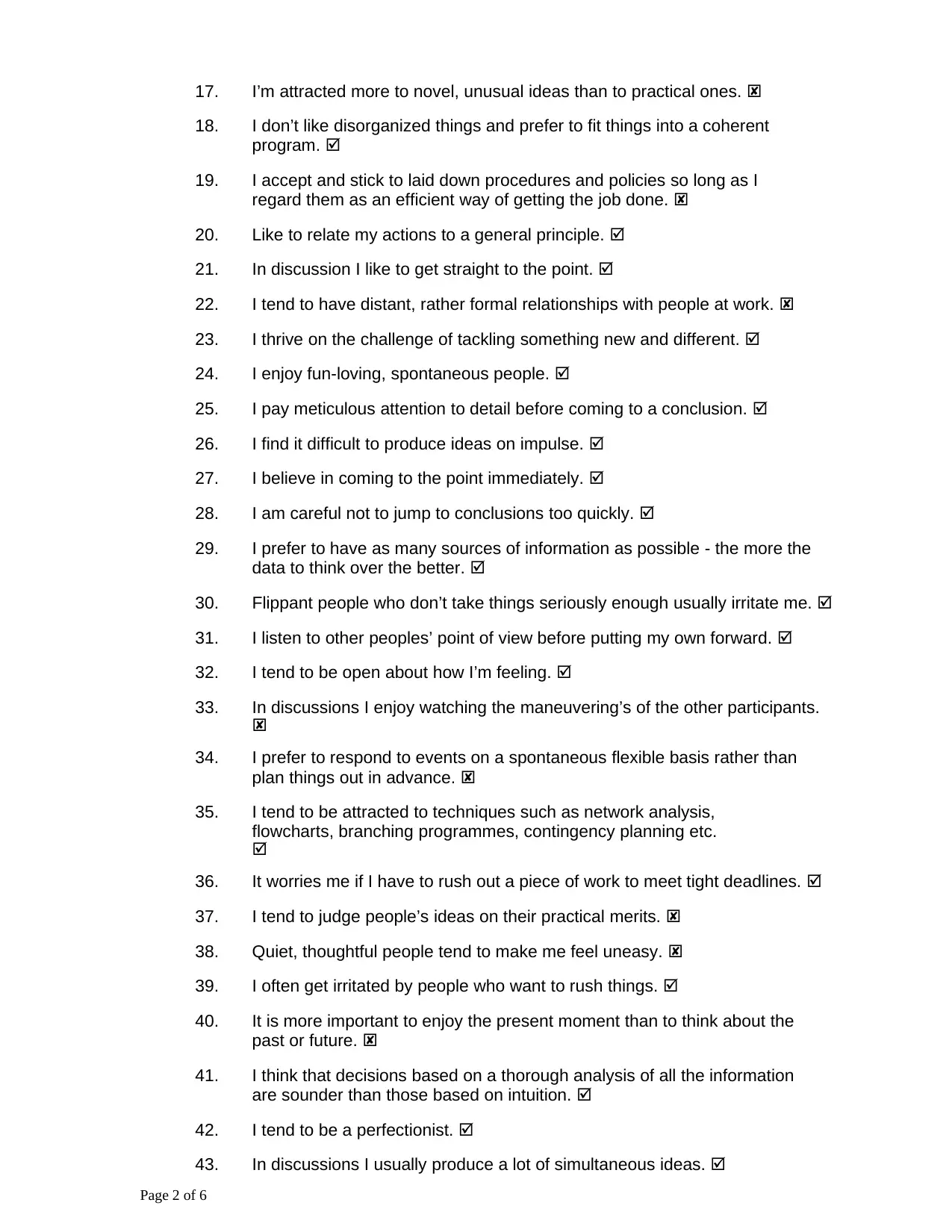
17. I’m attracted more to novel, unusual ideas than to practical ones.
18. I don’t like disorganized things and prefer to fit things into a coherent
program.
19. I accept and stick to laid down procedures and policies so long as I
regard them as an efficient way of getting the job done.
20. Like to relate my actions to a general principle.
21. In discussion I like to get straight to the point.
22. I tend to have distant, rather formal relationships with people at work.
23. I thrive on the challenge of tackling something new and different.
24. I enjoy fun-loving, spontaneous people.
25. I pay meticulous attention to detail before coming to a conclusion.
26. I find it difficult to produce ideas on impulse.
27. I believe in coming to the point immediately.
28. I am careful not to jump to conclusions too quickly.
29. I prefer to have as many sources of information as possible - the more the
data to think over the better.
30. Flippant people who don’t take things seriously enough usually irritate me.
31. I listen to other peoples’ point of view before putting my own forward.
32. I tend to be open about how I’m feeling.
33. In discussions I enjoy watching the maneuvering’s of the other participants.
34. I prefer to respond to events on a spontaneous flexible basis rather than
plan things out in advance.
35. I tend to be attracted to techniques such as network analysis,
flowcharts, branching programmes, contingency planning etc.
36. It worries me if I have to rush out a piece of work to meet tight deadlines.
37. I tend to judge people’s ideas on their practical merits.
38. Quiet, thoughtful people tend to make me feel uneasy.
39. I often get irritated by people who want to rush things.
40. It is more important to enjoy the present moment than to think about the
past or future.
41. I think that decisions based on a thorough analysis of all the information
are sounder than those based on intuition.
42. I tend to be a perfectionist.
43. In discussions I usually produce a lot of simultaneous ideas.
Page 2 of 6
18. I don’t like disorganized things and prefer to fit things into a coherent
program.
19. I accept and stick to laid down procedures and policies so long as I
regard them as an efficient way of getting the job done.
20. Like to relate my actions to a general principle.
21. In discussion I like to get straight to the point.
22. I tend to have distant, rather formal relationships with people at work.
23. I thrive on the challenge of tackling something new and different.
24. I enjoy fun-loving, spontaneous people.
25. I pay meticulous attention to detail before coming to a conclusion.
26. I find it difficult to produce ideas on impulse.
27. I believe in coming to the point immediately.
28. I am careful not to jump to conclusions too quickly.
29. I prefer to have as many sources of information as possible - the more the
data to think over the better.
30. Flippant people who don’t take things seriously enough usually irritate me.
31. I listen to other peoples’ point of view before putting my own forward.
32. I tend to be open about how I’m feeling.
33. In discussions I enjoy watching the maneuvering’s of the other participants.
34. I prefer to respond to events on a spontaneous flexible basis rather than
plan things out in advance.
35. I tend to be attracted to techniques such as network analysis,
flowcharts, branching programmes, contingency planning etc.
36. It worries me if I have to rush out a piece of work to meet tight deadlines.
37. I tend to judge people’s ideas on their practical merits.
38. Quiet, thoughtful people tend to make me feel uneasy.
39. I often get irritated by people who want to rush things.
40. It is more important to enjoy the present moment than to think about the
past or future.
41. I think that decisions based on a thorough analysis of all the information
are sounder than those based on intuition.
42. I tend to be a perfectionist.
43. In discussions I usually produce a lot of simultaneous ideas.
Page 2 of 6
Paraphrase This Document
Need a fresh take? Get an instant paraphrase of this document with our AI Paraphraser
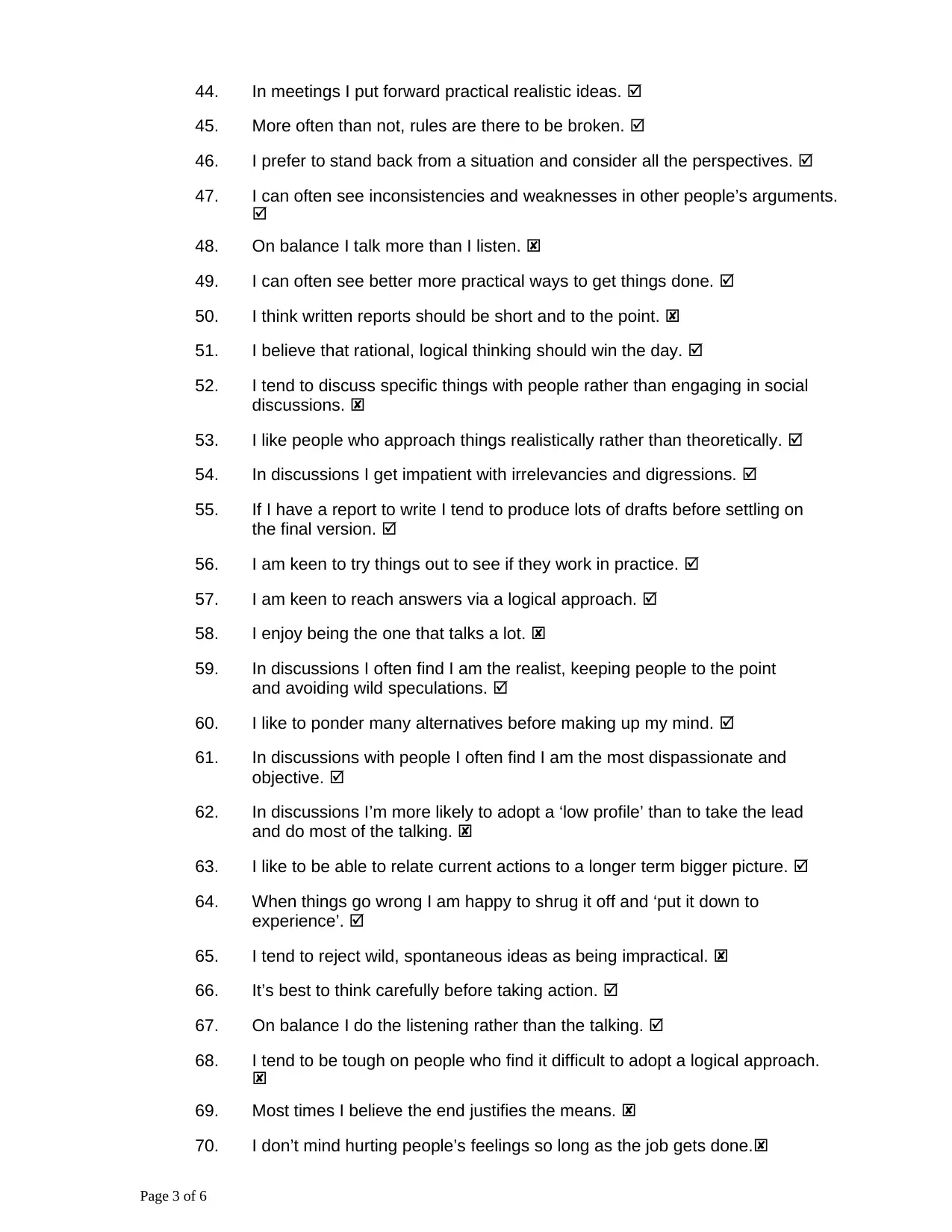
44. In meetings I put forward practical realistic ideas.
45. More often than not, rules are there to be broken.
46. I prefer to stand back from a situation and consider all the perspectives.
47. I can often see inconsistencies and weaknesses in other people’s arguments.
48. On balance I talk more than I listen.
49. I can often see better more practical ways to get things done.
50. I think written reports should be short and to the point.
51. I believe that rational, logical thinking should win the day.
52. I tend to discuss specific things with people rather than engaging in social
discussions.
53. I like people who approach things realistically rather than theoretically.
54. In discussions I get impatient with irrelevancies and digressions.
55. If I have a report to write I tend to produce lots of drafts before settling on
the final version.
56. I am keen to try things out to see if they work in practice.
57. I am keen to reach answers via a logical approach.
58. I enjoy being the one that talks a lot.
59. In discussions I often find I am the realist, keeping people to the point
and avoiding wild speculations.
60. I like to ponder many alternatives before making up my mind.
61. In discussions with people I often find I am the most dispassionate and
objective.
62. In discussions I’m more likely to adopt a ‘low profile’ than to take the lead
and do most of the talking.
63. I like to be able to relate current actions to a longer term bigger picture.
64. When things go wrong I am happy to shrug it off and ‘put it down to
experience’.
65. I tend to reject wild, spontaneous ideas as being impractical.
66. It’s best to think carefully before taking action.
67. On balance I do the listening rather than the talking.
68. I tend to be tough on people who find it difficult to adopt a logical approach.
69. Most times I believe the end justifies the means.
70. I don’t mind hurting people’s feelings so long as the job gets done.
Page 3 of 6
45. More often than not, rules are there to be broken.
46. I prefer to stand back from a situation and consider all the perspectives.
47. I can often see inconsistencies and weaknesses in other people’s arguments.
48. On balance I talk more than I listen.
49. I can often see better more practical ways to get things done.
50. I think written reports should be short and to the point.
51. I believe that rational, logical thinking should win the day.
52. I tend to discuss specific things with people rather than engaging in social
discussions.
53. I like people who approach things realistically rather than theoretically.
54. In discussions I get impatient with irrelevancies and digressions.
55. If I have a report to write I tend to produce lots of drafts before settling on
the final version.
56. I am keen to try things out to see if they work in practice.
57. I am keen to reach answers via a logical approach.
58. I enjoy being the one that talks a lot.
59. In discussions I often find I am the realist, keeping people to the point
and avoiding wild speculations.
60. I like to ponder many alternatives before making up my mind.
61. In discussions with people I often find I am the most dispassionate and
objective.
62. In discussions I’m more likely to adopt a ‘low profile’ than to take the lead
and do most of the talking.
63. I like to be able to relate current actions to a longer term bigger picture.
64. When things go wrong I am happy to shrug it off and ‘put it down to
experience’.
65. I tend to reject wild, spontaneous ideas as being impractical.
66. It’s best to think carefully before taking action.
67. On balance I do the listening rather than the talking.
68. I tend to be tough on people who find it difficult to adopt a logical approach.
69. Most times I believe the end justifies the means.
70. I don’t mind hurting people’s feelings so long as the job gets done.
Page 3 of 6

71. I find the formality of having specific objectives and plans stifling.
72. I’m usually one of the people who put life into a party.
73. I do whatever is expedient to get the job done.
74. I quickly get bored with methodical, detailed works.
75. I am keen on exploring the basic assumptions, principles and
theories underpinning things and events.
76. I’m always interested to find out what people think.
77. I like meetings to be run on methodical lines, sticking to laid down
agenda etc.
78. I steer clear of subjective or ambiguous topics.
79. I enjoy the drama and excitement of a crisis situation.
80. People often find me insensitive to their feelings.
You score one point for each item you ticked . There are no points for items you crossed .
Simply indicate on the lists below which items were ticked.
2 7 1 6
4 13 3 9
5 15 8 11
10 16 12 19
17 25 14 21
23 28 18 27
24 29 20 35
32 31 22 37
34 33 26 44
38 36 30 49
40 39 42 50
43 41 47 53
45 46 51 54
48 52 57 56
58 55 61 59
64 60 63 65
71 62 68 69
72 66 75 70
74 67 77 73
79 76 78 80
Totals
Activist
11
Reflector
17
Theorist
18
Pragmatist
13
Page 4 of 6
72. I’m usually one of the people who put life into a party.
73. I do whatever is expedient to get the job done.
74. I quickly get bored with methodical, detailed works.
75. I am keen on exploring the basic assumptions, principles and
theories underpinning things and events.
76. I’m always interested to find out what people think.
77. I like meetings to be run on methodical lines, sticking to laid down
agenda etc.
78. I steer clear of subjective or ambiguous topics.
79. I enjoy the drama and excitement of a crisis situation.
80. People often find me insensitive to their feelings.
You score one point for each item you ticked . There are no points for items you crossed .
Simply indicate on the lists below which items were ticked.
2 7 1 6
4 13 3 9
5 15 8 11
10 16 12 19
17 25 14 21
23 28 18 27
24 29 20 35
32 31 22 37
34 33 26 44
38 36 30 49
40 39 42 50
43 41 47 53
45 46 51 54
48 52 57 56
58 55 61 59
64 60 63 65
71 62 68 69
72 66 75 70
74 67 77 73
79 76 78 80
Totals
Activist
11
Reflector
17
Theorist
18
Pragmatist
13
Page 4 of 6
⊘ This is a preview!⊘
Do you want full access?
Subscribe today to unlock all pages.

Trusted by 1+ million students worldwide
1 out of 16
Related Documents
Your All-in-One AI-Powered Toolkit for Academic Success.
+13062052269
info@desklib.com
Available 24*7 on WhatsApp / Email
![[object Object]](/_next/static/media/star-bottom.7253800d.svg)
Unlock your academic potential
Copyright © 2020–2025 A2Z Services. All Rights Reserved. Developed and managed by ZUCOL.





